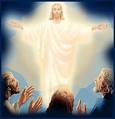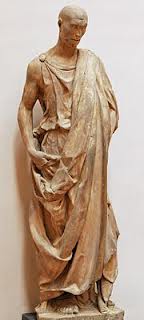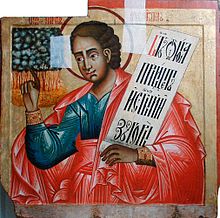
| Next | Previous | Index | Tellout Home |
Revelation's Prophet John
Disciple Whom Jesus Loved
 Revelation's prophet John is writing to us from the Early Church in c90-95 AD. An early fragment of John's Gospel from c135 AD gives us this date. Another New Testament papyri, known as Papyrus 46, shows parts of 2 Corinthians 11.33-12.9. Papyrus is a material similar to brown wrapping paper used as a writing surface in ancient times. It was produced from the papyrus' plant pith, "Cyperus papyrus," a wetland sedge. Papyri drawings are very popular as tourist keepsakes in Egypt. My wife and I have four on our corridor wall showing tomb paintings. In the ruins of Herculaneum, archaeologists unearthed a beautiful Roman portrait fresco showing a young man with a papyrus scroll in his hands from the 1st century AD. John wrote his Gospel after the other Gospels, indicating a dating of 90-95 AD. ✞
Revelation's prophet John is writing to us from the Early Church in c90-95 AD. An early fragment of John's Gospel from c135 AD gives us this date. Another New Testament papyri, known as Papyrus 46, shows parts of 2 Corinthians 11.33-12.9. Papyrus is a material similar to brown wrapping paper used as a writing surface in ancient times. It was produced from the papyrus' plant pith, "Cyperus papyrus," a wetland sedge. Papyri drawings are very popular as tourist keepsakes in Egypt. My wife and I have four on our corridor wall showing tomb paintings. In the ruins of Herculaneum, archaeologists unearthed a beautiful Roman portrait fresco showing a young man with a papyrus scroll in his hands from the 1st century AD. John wrote his Gospel after the other Gospels, indicating a dating of 90-95 AD. ✞
Traditional Recognition
 Many Bible Scholars and students traditionally recognize Revelation's writer as John, the son of Zebedee, one of the Apostles and "the disciple whom Jesus loved." The early second century writers, Justin Martyr (100-165 AD), Irenaeus (c130-c202 AD), Bishop Melito of Sardis, (?-180 AD) who coined the term "Old Testament" or "Old Books," and Clement of Alexandria (150-215 AD) identified the author of Revelation as John the Evangelist, the disciple of Jesus.
Many Bible Scholars and students traditionally recognize Revelation's writer as John, the son of Zebedee, one of the Apostles and "the disciple whom Jesus loved." The early second century writers, Justin Martyr (100-165 AD), Irenaeus (c130-c202 AD), Bishop Melito of Sardis, (?-180 AD) who coined the term "Old Testament" or "Old Books," and Clement of Alexandria (150-215 AD) identified the author of Revelation as John the Evangelist, the disciple of Jesus.
Traditionally, John of Patmos was the author of John's Gospel, the Johannine Epistles, and the Book of Revelation. He called himself "the disciple whom Jesus loved" and spoke fondly of his Lord and Savior, writing from his cave on the Greek prison Isle of Patmos. He reveals to us divine revelation truths for today and our destiny tomorrow. ✞
God Has Been Gracious
John of Patmos, whose name means "God has been gracious," repeats for us Jesus' words in Revelation 3.16, "I know your deeds, that you are neither cold nor hot." After being plunged into a vat of boiling oil and miraculously surviving, the authorities banished John to the Island of Patmos! Patmos was Patmos was one of three Greek coastal islands situated about 50 miles offshore from Ephesus in the Aegean Sea to which the Romans banished political offenders. To this day, icons bearing his image show a scar from boiling oil down one side of his head. He is probably the only one of Jesus' Apostles who lived a long life and died a natural death. Leaders, princes, and officials visited him on Patmos to seek his godly advice in his day. ✞
John's Imprisonment
 John of Patmos was the same disciple whom Jesus loved. He saw the Lord, whom he knew as a friend, return as a triumphant King. In his book, "Natural History," the secular author Pliny the Elder (23-79 AD) reported that banishment was a regular punishment for many offenses, including magic and astrology. The Romans viewed Pagan, Jewish, or Christian prophecy similarly and perceived John as a threat to political power and order. ✞
John of Patmos was the same disciple whom Jesus loved. He saw the Lord, whom he knew as a friend, return as a triumphant King. In his book, "Natural History," the secular author Pliny the Elder (23-79 AD) reported that banishment was a regular punishment for many offenses, including magic and astrology. The Romans viewed Pagan, Jewish, or Christian prophecy similarly and perceived John as a threat to political power and order. ✞
John's End
 According to tradition, "John of Patmos" was the only original Apostle to die a natural death and not martyred for his faith. "John" traditionally suffered at the Romans' hands Emperor Domitian's persecution (51-96 AD). Legend has it that somebody placed poison into John's wine goblet, but a snake-like head arose out of it and alerted him. John of Patmos and many other Christian believers suffered, and large numbers martyred during this empire-wide persecution. John sought to encourage survivors to persevere faithfully. ✞
According to tradition, "John of Patmos" was the only original Apostle to die a natural death and not martyred for his faith. "John" traditionally suffered at the Romans' hands Emperor Domitian's persecution (51-96 AD). Legend has it that somebody placed poison into John's wine goblet, but a snake-like head arose out of it and alerted him. John of Patmos and many other Christian believers suffered, and large numbers martyred during this empire-wide persecution. John sought to encourage survivors to persevere faithfully. ✞
John's Special Vision
 God shows these beautiful things to "John of Patmos" in a spectacular and mysterious vision. John is not attempting to predict the future here but to faithfully record and "obediently describe the wonders shown to him." We make a grave mistake if we reconstruct a definitive calendar of future events from these chapters. On certain occasions, John is told not to write down what he saw. Only Christ himself will fill in the blanks when he comes! ✞
God shows these beautiful things to "John of Patmos" in a spectacular and mysterious vision. John is not attempting to predict the future here but to faithfully record and "obediently describe the wonders shown to him." We make a grave mistake if we reconstruct a definitive calendar of future events from these chapters. On certain occasions, John is told not to write down what he saw. Only Christ himself will fill in the blanks when he comes! ✞
John of Patmos
 Many students know John by many titles. He is sometimes known as John of Patmos, John the Evangelist, John the Divine, the Apostle John. In this study of the Book of Revelation, I use John of Patmos to refer to the Revelation writer for clarity. He is a prophet and visionary and bound by an oath in Revelation to write down only what he sees, nothing more and nothing less. He is faithful in that task, even though he does not always understand what he describes. We are shown the radiant Jesus in all his glory in the heavenly realms speaking to his church through graphic word pictures. John of Patmos gives us a clue in Revelation about why we are born and our eternal destiny! ✞
Many students know John by many titles. He is sometimes known as John of Patmos, John the Evangelist, John the Divine, the Apostle John. In this study of the Book of Revelation, I use John of Patmos to refer to the Revelation writer for clarity. He is a prophet and visionary and bound by an oath in Revelation to write down only what he sees, nothing more and nothing less. He is faithful in that task, even though he does not always understand what he describes. We are shown the radiant Jesus in all his glory in the heavenly realms speaking to his church through graphic word pictures. John of Patmos gives us a clue in Revelation about why we are born and our eternal destiny! ✞
William Barclay
 The Book of Revelation is unfortunately presented unfairly by many commentators as "sensational and incomprehensible." On the contrary, Revelation is a beautiful Biblical book. John of Patmos's writing frames it in Roman customs and the ethos of the last part of the first century AD. No expositor or commentator, in my estimation, contributed more to Revelation's study and understanding than Dr. William Barclay (1907-1978 AD). He was a distinguished Scottish author, radio and television presenter, Church of Scotland minister, and Professor of Divinity and Biblical Criticism at Glasgow University. He was enormously popular in his lifetime. He wrote Bible study commentaries on the whole Bible through the St Andrew's Press. He spoke daily to ordinary folk in his radio broadcasts about Revelation and other Bible books in simple terms to encourage and educate working men and women. ✞
The Book of Revelation is unfortunately presented unfairly by many commentators as "sensational and incomprehensible." On the contrary, Revelation is a beautiful Biblical book. John of Patmos's writing frames it in Roman customs and the ethos of the last part of the first century AD. No expositor or commentator, in my estimation, contributed more to Revelation's study and understanding than Dr. William Barclay (1907-1978 AD). He was a distinguished Scottish author, radio and television presenter, Church of Scotland minister, and Professor of Divinity and Biblical Criticism at Glasgow University. He was enormously popular in his lifetime. He wrote Bible study commentaries on the whole Bible through the St Andrew's Press. He spoke daily to ordinary folk in his radio broadcasts about Revelation and other Bible books in simple terms to encourage and educate working men and women. ✞
Scriptures Come Alive
 Dr. Barclay concluded a distinguished ministry as a Glasgow University professor and passed away in 1968. I started my ministry in 1970 as a young man at the Bible Training Institute on Bothwell Street in Glasgow, which is now the International Christian College. Though we never crossed paths physically, he left a deep spiritual impression on me from his writings. The Book of Revelation speaks to ordinary people. Dr. Barclay, more than anyone else, makes the Scriptures come alive. He draws on scholarship but also writes in a highly accessible style. ✞
Dr. Barclay concluded a distinguished ministry as a Glasgow University professor and passed away in 1968. I started my ministry in 1970 as a young man at the Bible Training Institute on Bothwell Street in Glasgow, which is now the International Christian College. Though we never crossed paths physically, he left a deep spiritual impression on me from his writings. The Book of Revelation speaks to ordinary people. Dr. Barclay, more than anyone else, makes the Scriptures come alive. He draws on scholarship but also writes in a highly accessible style. ✞
Jesus Made Alive
I love the story that when asked to read a lesson in the Presbyterian Church he attended regularly, he pulled out the Hebrew and Greek originals from his pocket and translated them "on the fly." In his book, "The Mind of Christ," Dr. Barclay states his aim "to make the figure of Jesus more vividly alive so that we may know him better and love him more." I hope and pray that this book on John's great Revelation will do just that for you! I owe a debt of gratitude to the scholarly works I have consulted over years of study and the many people with whom I have shared my ideas. Revelation has absorbed my energies as I have discovered more and more about it. ✞
Glimpse Of Glory
 Revelation may be a vision of splendor, but it is also written for ordinary folk, like you and me, to build us up and bless us. "A Glimpse of Glory" takes the same approach. I hope that, like those early Christians, we might grow in the Christian Faith. We will also view Jesus of Nazareth in a new light as the "eternal glorious one." He may be our "savior" now, but we will see him one day as our "glorious Lord." ✞
Revelation may be a vision of splendor, but it is also written for ordinary folk, like you and me, to build us up and bless us. "A Glimpse of Glory" takes the same approach. I hope that, like those early Christians, we might grow in the Christian Faith. We will also view Jesus of Nazareth in a new light as the "eternal glorious one." He may be our "savior" now, but we will see him one day as our "glorious Lord." ✞
Living by Faith
 Like John of Patmos, Habakkuk was a Biblical prophet and the eighth of twelve collected minor prophets. Of the three chapters in his book, the first two are dialogs between God and the prophet. The central message from Habakkuk 2.4 is that "The just shall live by his faith." This concept comes to play an essential role in present-day Christian thought. Habakkuk's Revelation comes from three thousand years ago as a precursor to the Revelation prophetic apocalypse. Long before John of Patmos came on the scene, the prophet Habakkuk spoke and wrote of the "end times" in the seventh century BC. ✞
Like John of Patmos, Habakkuk was a Biblical prophet and the eighth of twelve collected minor prophets. Of the three chapters in his book, the first two are dialogs between God and the prophet. The central message from Habakkuk 2.4 is that "The just shall live by his faith." This concept comes to play an essential role in present-day Christian thought. Habakkuk's Revelation comes from three thousand years ago as a precursor to the Revelation prophetic apocalypse. Long before John of Patmos came on the scene, the prophet Habakkuk spoke and wrote of the "end times" in the seventh century BC. ✞
Habakkuk's Revelation
 In Habakkuk 2.2-3, the prophet wrote, "Then the Lord answered me and said, 'Write the vision and make it plain on tablets, that he may run who reads it. The vision is yet for an appointed time, but in the end, it will speak, and it will not lie. Though it tarries, wait for it because it will surely come, it will not tarry.'" Habakkuk's Revelation brings us an excellent forecast of future things that will happen. The Lord himself is the speaker, and he tells Habakkuk to "Write down the revelation" to encourage his distant future listeners. Today, we have Habakkuk's words authenticated by John of Patmos. We can be sure of the story's completion, whether for Habakkuk's listeners from three or four thousand years ago or for other Christians perhaps a thousand years in the future. Though we do not know the date or time, we should wait for its certainty. It will surely come. It will not tarry! The end may appear at any time! ✞
In Habakkuk 2.2-3, the prophet wrote, "Then the Lord answered me and said, 'Write the vision and make it plain on tablets, that he may run who reads it. The vision is yet for an appointed time, but in the end, it will speak, and it will not lie. Though it tarries, wait for it because it will surely come, it will not tarry.'" Habakkuk's Revelation brings us an excellent forecast of future things that will happen. The Lord himself is the speaker, and he tells Habakkuk to "Write down the revelation" to encourage his distant future listeners. Today, we have Habakkuk's words authenticated by John of Patmos. We can be sure of the story's completion, whether for Habakkuk's listeners from three or four thousand years ago or for other Christians perhaps a thousand years in the future. Though we do not know the date or time, we should wait for its certainty. It will surely come. It will not tarry! The end may appear at any time! ✞
"Revelation's Prophet John"
by Ron Meacock © 2021
| ^Top Page | Next | Previous |